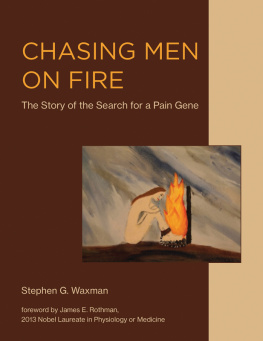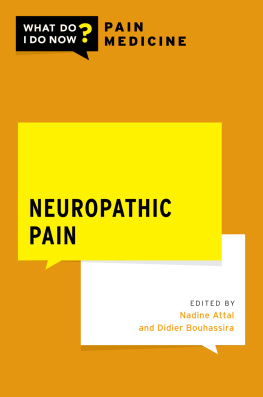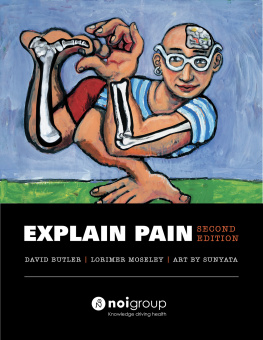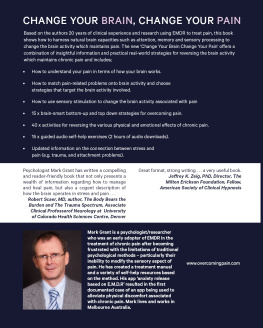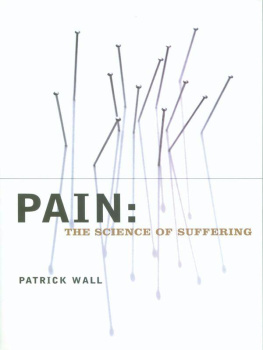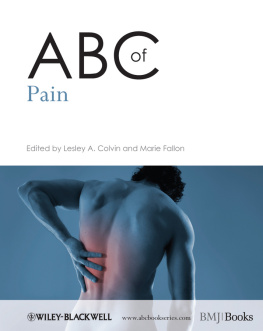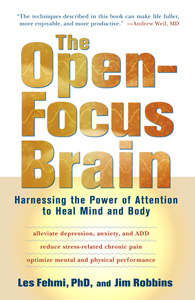Chasing Men on Fire
The Story of the Search for a Pain Gene
Stephen G. Waxman
The MIT Press
Cambridge, Massachusetts
London, England
2018 Massachusetts Institute of Technology
All rights reserved. No part of this book may be reproduced in any form by any electronic or mechanical means (including photocopying, recording, or information storage and retrieval) without permission in writing from the publisher.
This book was set in Helvetica LT Std and Times New Roman by Toppan Best-set Premedia Limited. Printed and bound in the United States of America.
Library of Congress Cataloging-in-Publication Data is available.
Names: Waxman, Stephen G., author.
Title: Chasing men on fire : the story of the search for a pain gene / Stephen G. Waxman ; foreword by James E. Rothman.
Description: Cambridge, MA : The MIT Press, [2018] | Includes bibliographical references and index.
Identifiers: LCCN 2017026622 | ISBN 9780262037402 (hardcover : alk. paper)
eISBN 9780262344715
Subjects: | MESH: Pain--genetics | Pain Management | NAV1.7 Voltage-Gated Sodium Channel
Classification: LCC RB127 | NLM WL 704 | DDC 616/.0472--dc23 LC record available at https://lccn.loc.gov/2017026622
ePub Version 1.0
For P, G, and those who shared their DNA.
And for M, W, RT, and JD; for D, J, CJ, and L; and of course for M
Foreword
If you are interested in how scientific medicine is done, this is cause enough to read this book. Whether you are a layperson or a scientist, if you are interested in the brain and the nervous system, you will also be interested because Waxman explains the ideas and their history so clearly and simply and yet accurately. Indeed the book is so well written that it reads like a detective novel, making it irresistible to turn the next page (or swipe the screen of your Kindle).
The explicit focus is Waxmans lifelong pursuit as a neurologist of how pain arises, how we can better understand it, and how new medicines for pain can be developed to treat it. He has had remarkable success in this pursuit initially through the discovery of a gene that controls pain. Waxmans decades-long path of discovery offers important lessons concerning how important progress in medicine is achieved: taking a risk in tackling a seemingly insurmountable problem, staying the course, following the scientific method with rigor and enthusiasm.
I have had the opportunity of following the bookends of the story close up, first as Steve Waxmans colleague at Stanford Medical School in the late 1970s, near the beginning, and now at Yale School of Medicine. Waxman, trained both as a neurologist and a molecular neuroscientist, begins by noting, Two soldiers may both have missile wounds injuring the same nerve. One is disabled by neuropathic pain, unable to touch the injured limb because feather-light contact triggers immense discomfort, while the other notices numbness but no pain at all. And he then poses the question, Might the difference lie in their genes?
Genes can teach us much about human health and disease. One way to pinpoint critically important genes is to locate and study families in which an experiment of naturea mutated genecauses inherited disease. This approach has famously led to the discovery of genes influencing many diseases ranging from cystic fibrosis in children to Alzheimers disease in the aging. Waxman has followed this path in a worldwide searcha hunt that spanned forty years and thousands of milesfor families with inherited pain. Within these very unusual families there was a secret, a gene that encodes a master switch that can turn pain on or off.
Interestingly, the story is told via two intertwined narratives. The scientific narrative is relayed by a series of research papers intended for professional scientists that illustrate the steps forward in the search for a pain gene. These papers provide an excellent example of bench to bedside research that, in this case, reaches from genes, to molecules that enable neurons to signal each other, then to pain-signaling nerve cells that shriek when they should be whispering, and finally to people who feel they are on fire, people suffering from excruciating pain due to alterations in a single gene. These people on fire provide a genetic model of neuropathic pain.
Happily for the nonspecialist, the primary research papers are accompanied by commentaries that explain what the research means, why it needed to be done, and how it was done. Here we get a rare glimpse, provided by a working scientist, into how scientific collaborations arise, how discoveries are made, how a finding on one disease can inform research on other disorders, and how research is translated from the laboratory bench to the clinic. These personal accounts tell a story of how science happens.
The identification of a pain gene may be relevant to many of us. Following up on the identification of one specific gene as a central player in the man on fire syndrome, research on that gene has extended to the broader general population, where it is important in common disorders such as trigeminal neuralgia that can affect any of us. Research on this gene also provides a vivid example of the developing strategy of precision medicine, guided by genomics, that has the promise of relieving pain first time around. It may also point the way toward development of a new class of pain medications that are more effective and that do not have addictive potential. While much remains to be accomplished before the scourge of chronic pain can be effectively treated in most people, we now have a strong scientific foundation that in the fullness of time will enable this, thanks in significant part to the passionate and effective contributions chronicled here.
James E. Rothman
Nobel Laureate in Physiology or Medicine (2013)
Professor, Yale University
Preface
This volume had its origin when several people suggested that I write a book on my search for a pain gene, a gene that controls pain sensibility in humans. Each suggested that the topic was timely, but each imagined a book for a different audience. A colleague forwarded the idea of a text for scientists-in-training and physicians-in-training, another suggested a book for a lay readership interested in pain, and still another suggested a volume for scientists and physicians. In the end, after consulting with colleagues, book publishers, and editors, and ultimately with Bob Prior of MIT Press, I decided to take a hybrid approach, combining some of my primary papers with commentaries that place them in a broader context in order to reach all these audiences.
Chronic pain affects more than 250 million sufferers around the world, is a leading cause of disability, and occurs more frequently than cancer, heart disease, and diabetes combined. The available pain medications are often ineffective or only partially effective. The number of patients needed to be treated, in order to achieve a 50% reduction in pain, is more than four for most of the currently available medications. And, many of the currently available pain medications produce side effects that impair quality of life and limit their use. There is a pressing need for new and better pain medications, and that, in turn, requires that we understand pain at a fundamental level.
The cells within our bodies, including pain-signaling nerve cells, are built largely of protein molecules. The blueprints for these essential building blocks are contained within the human genome, within more than 20,000 genes. Thus genes can tell us how pain-signaling nerve cells work, and might show us how to design new medications.
This type of genetic approach propelled the development of the statin medications, which regulate our lipid levels and have had an immense impact on health. In the case of the statins, it was the discovery and study of very rare families with inherited hypercholesterolemia that pointed the way to drugable molecular targets and ultimately to a new class of medicines. Rare genetic disorders can teach us important lessons about more common diseases. By analogy to the statins, the discovery of a pain gene would almost certainly teach us important lessons about chronic pain and how it arises. It also might facilitate the development of more effective pain medications, hopefully devoid of central side effects such as confusion, loss of balance, sleepiness, and addictive potential.

